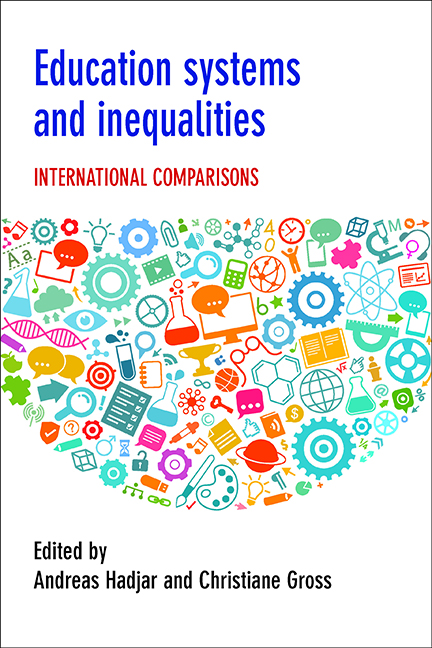Book contents
- Frontmatter
- Contents
- List of tables and figures
- Notes on contributors
- Acknowledgements
- Introduction: education systems and inequalities
- one Theorising the impact of education systems on inequalities
- two Comparing education policies in a globalising world: methodological reflections
- three Education systems and intersectionality
- four Measuring educational institutional diversity: tracking, vocational orientation and standardisation
- five Sorting and (much) more: prior ability, school effects and the impact of ability tracking on educational inequalities in achievement
- six Data analysis techniques to model the effects of education systems on educational inequalities
- seven Education systems and inequality based on social origins: the impact of school expansion and design
- eight Education systems and gender inequalities in educational attainment
- nine Tracking, school entrance requirements and the educational performance of migrant students
- ten From exclusion and segregation to inclusion? Dis/ability-based inequalities in the education systems of Germany and Nigeria
- eleven Education systems and meritocracy: social origin, educational and status attainment
- twelve Education systems and gender inequalities in educational returns
- thirteen Education systems and migrant-specific labour market returns
- fourteen Health returns on education and educational systems
- fifteen Good and bad education systems: is there an ideal?
- Conclusions and summary
- Index
eight - Education systems and gender inequalities in educational attainment
Published online by Cambridge University Press: 05 April 2022
- Frontmatter
- Contents
- List of tables and figures
- Notes on contributors
- Acknowledgements
- Introduction: education systems and inequalities
- one Theorising the impact of education systems on inequalities
- two Comparing education policies in a globalising world: methodological reflections
- three Education systems and intersectionality
- four Measuring educational institutional diversity: tracking, vocational orientation and standardisation
- five Sorting and (much) more: prior ability, school effects and the impact of ability tracking on educational inequalities in achievement
- six Data analysis techniques to model the effects of education systems on educational inequalities
- seven Education systems and inequality based on social origins: the impact of school expansion and design
- eight Education systems and gender inequalities in educational attainment
- nine Tracking, school entrance requirements and the educational performance of migrant students
- ten From exclusion and segregation to inclusion? Dis/ability-based inequalities in the education systems of Germany and Nigeria
- eleven Education systems and meritocracy: social origin, educational and status attainment
- twelve Education systems and gender inequalities in educational returns
- thirteen Education systems and migrant-specific labour market returns
- fourteen Health returns on education and educational systems
- fifteen Good and bad education systems: is there an ideal?
- Conclusions and summary
- Index
Summary
Gender inequalities in educational attainment are of central concern today, in both public and scientific discourses. Prior to the rapid expansion of the educational systems of most industrialised societies in the 1960s, male educational attainment was higher than that of females nearly everywhere in the world. As the educational systems of industrialised nations expanded, both in the size and diversity of their populations, opportunities for women also grew, and girls benefited substantially. Today, throughout most industrialised regions of the world, girls attain better grades in school, take more challenging classes and achieve higher overall results. Due in part to their stronger academic performance, girls are now more likely than boys to enrol in upper secondary schools. Gender segregation in fields of study and vocations persists to the extent that men and women tend to specialise in very different areas.
This chapter presents an account of contemporary patterns of gender inequalities in educational attainment in industrialised societies. It then discusses theoretical explanations for the different types of gender inequalities in education and the reasons for changing gender inequalities in education over time. It considers micro-level explanations of gender differences in school performance and educational attainment, as well as the impacts of variations educational systems and societal-level characteristics on gender inequalities in education. The chapter concludes with a multi-level analysis investigating how variations in educational systems and societal-level characteristics impact gender inequalities.
Gender inequalities in education
Gender inequalities in education are differences between boys and girls or men and women in a broad variety of aspects of education at different stages of the educational career. We define gender inequalities in education as systematic variations in aspects related to education that are structured along gender as an axis of inequality. Such aspects of education include access to educational institutions, placement in educational tracks or pathways, educational achievement as indicated by grades, test scores and credentials, as well as educational attainment. Other factors related to educational achievement and attainment outcomes, including student motivation, subjective well-being in school, interests and self-perceptions, can also be examined along gendered lines. Differences in aspects that can be hierarchically ordered such as grades, test scores and educational credentials are commonly referred to as vertical inequalities; aspects that do not directly relate to hierarchical ordering but to heterogeneity, such as field of study, are commonly referred to as horizontal inequalities (Charles, 2003; Watts, 2005).
- Type
- Chapter
- Information
- Education Systems and InequalitiesInternational Comparisons, pp. 159 - 184Publisher: Bristol University PressPrint publication year: 2016



